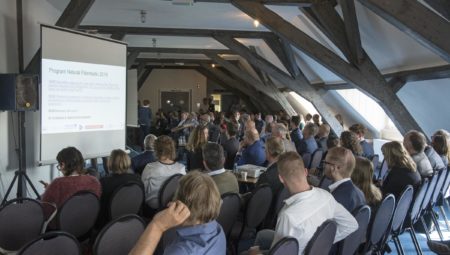The existing concrete viaduct was totally refitted for this purpose. Wooden guard rails were installed with a striking façade made from green bio-based vertical sections, with a total length of six kilometres if you laid them end to end. They were produced by the Belgian manufacturer Exel Composites from biocomposite and reinforced with flax fibres.
Opting for bio-based
‘This allows us to show we are working with bio-based construction on a large scale,’ says Esther Stapper, coordinator of Groen verbouwen (Growing green) at Biobased Delta. ‘The Zoomland viaduct is simultaneously a showcase and a testing ground for us. It is a way for us to inspire other parties to opt for bio-based.’
This applies, for instance, to the many municipalities and the Province of Noord-Brabant which were represented at the mini symposium. They listened with great attention to the experiences of businesses involved in the construction of the viaduct. Thus Excel Composites discussed the production of vertical sections from a material whose features were totally different to those of the customary glass fibre and fossil-based chemicals it is accustomed to working with. LOLA Landscape architects spoke about designing with bio-based materials, while Dura Vermeer told about processing them. Alderman Van der Velden spoke about the bio-based projects indoors and outdoors at Bergen op Zoom, and project leader Ward Vansteelandt talked about the Turf Route of which the Zoomland viaduct forms a part. Millvision was also present, to share its experiences in the entire building process with the parties present.
Stapper: ‘The composite elements were made using a process called pultrusion. This means drawing long fibres through a resin bath with a thermosetting polymer. However, flax has a certain humidity level which does not allow the resin to adhere directly. Besides, in its unprocessed state it has low mechanical strength. Processing with the pultrusion technique required the flax to be dried first and the machines to be set to different settings.’
Put to the test
Now that we have knowledge about how to use flax in pultrusion, the technique can also be used for numerous other applications, such as making parts for buses. However, the materials must first be proven in practice. And that is happening on the Zoomland viaduct. It has been put to the test severely in recent months, with an extreme storm and snow in January, full sunshine during the day and freezing cold nights in February.
‘From the Natural Fibre Application Centre we are closely monitoring how the material stands up,’ says Esther Stapper. ‘Will it lose colour? Will it warp? Does the effect of moisture make the fibre expand?’ This is all the more important because the structure is suspended above the motorway and the safety of motorists must be guaranteed. The first results are highly promising.
Natural Fibertastic
The experiences with the Zoomland viaduct show how SME businesses affiliated with the Biobased Delta can use innovative fibre technology to make a difference in the bio-based economy. That theme will also be explored in more depth at the Natural Fibertastic event held on 19 April 2018 in Bergen op Zoom. The event has an international character, because many European parties know that the Delta region is the place to go for research and prototype development.
The emphasis at Natural Fibertastic will be on the use of (natural) fibres for materials for diverse applications, such as for construction and infrastructural projects. Esther Stapper, one of the speakers at this event, believes that the objective is also to give a glimpse of developments in other sectors: ‘We can learn from each other.’ Real-life cases, challenges and solutions within the scope of matters such as scaling up, quality, realisation and funding are discussed through presentations and a natural fibre materials and products market. There are also opportunities for matchmaking, and sufficient space for networking.
In the morning, project meetings will be held in parallel sessions which tie in with the development programme of the Natural Fibre Application Programme. Partners are invited specifically for this. The afternoon comprises a plenary programme, with many practical examples and experiences being reviewed, carrying the working title: ‘By entrepreneurs for entrepreneurs.’ Would you like to register? You can do so by sending an email to welcome@natuurvezelapplicatiecentrum.eu
This article was created in cooperation with Biobased Delta
Photo by Dura Vermeer/Sebastiaan Knot



